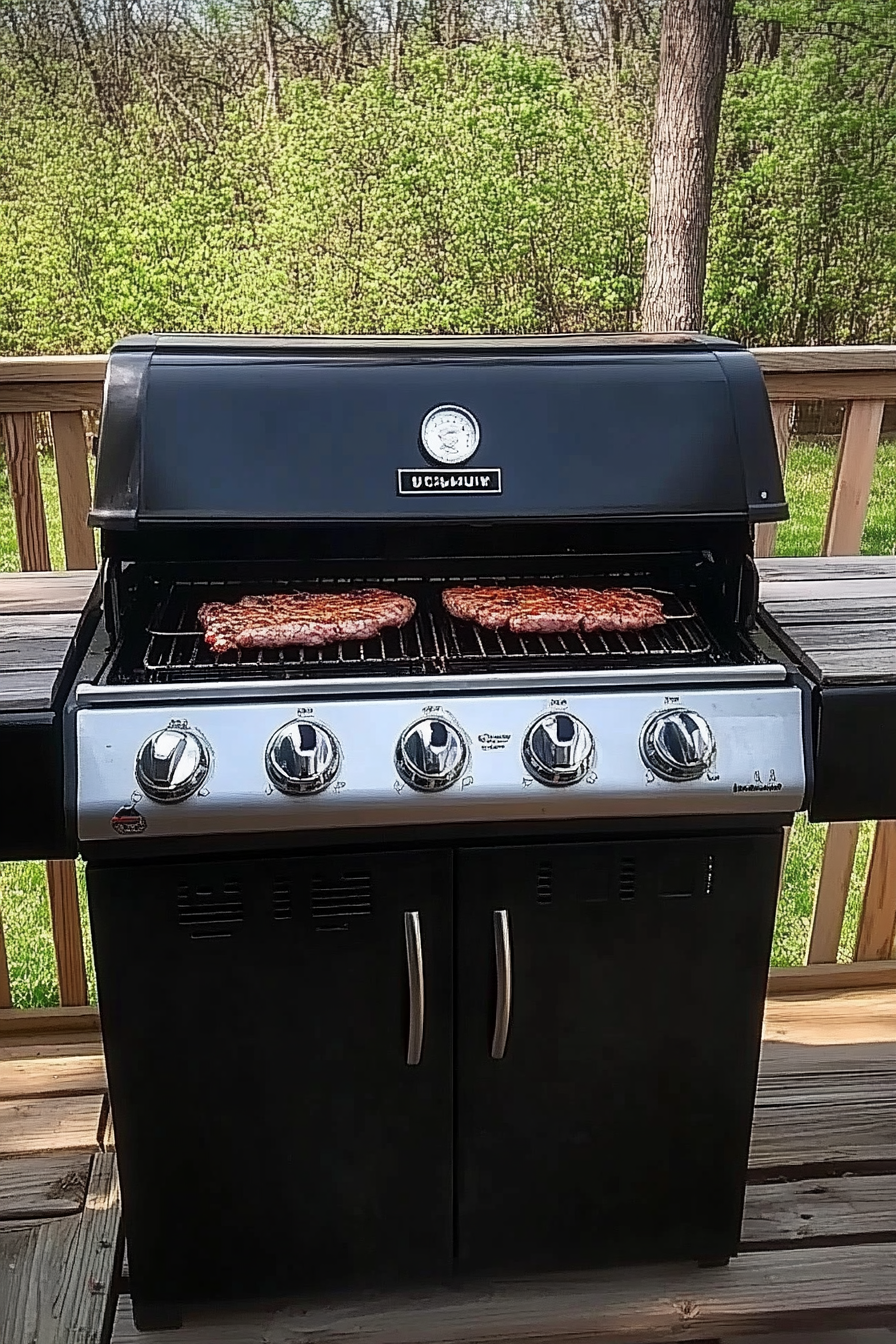There’s something magical about a perfectly grilled meal. The smoky char, the tender interiors, the whole experience just screams summer to me, even in the middle of winter. But let’s be honest, that magic can quickly turn into a greasy nightmare if your grill isn’t in tip-top shape. I remember one disastrous backyard party years ago – everything stuck, smoke billowed in all the wrong places, and the cleanup? Don’t even get me started. It was a wake-up call! Since then, I’ve honed a method for keeping my clean gas grill in pristine condition, and it’s honestly not as daunting as it sounds. It’s more about consistency than brute force, and trust me, the results are *so* worth it. This isn’t just about making your grill look pretty; it’s about ensuring every meal you cook is delicious and safe.
What is clean gas grill?
So, what exactly are we aiming for when we talk about a “clean gas grill”? It’s not about having a showroom-worthy appliance that sparkles under the sun (though that’s a nice bonus!). A truly clean gas grill means it’s free from built-up grease, charred food particles, and debris that can affect cooking performance and, more importantly, your food’s flavor. Think of it as a chef’s clean cutting board – essential for good results. It means the grates are smooth and ready to sear, the burners are clear to produce even heat, and the interior isn’t a fire hazard waiting to happen. It’s about maintaining the integrity of your grill so it performs at its best, every single time you fire it up. It’s essentially a well-maintained tool ready for culinary creation.
Why do people love this method?
Honestly, the biggest reason I stick to this routine is how much easier it makes my life in the long run. No more wrestling with stubborn, caked-on gunk! Here’s the lowdown on why I think you’ll be a convert too:
- Flavor Preservation: What is the best way to preserve a flavor? This is huge for me. When your grill is clean, your food tastes like *your* food, not like the burnt remnants of last week’s dinner. That beautiful sear you’re going for? It happens perfectly on clean grates.
- Ease of Cooking: What are some tips for a beginner? Sticky food is the bane of any griller’s existence. A clean gas grill means less sticking, which means beautifully cooked proteins and veggies that slide right off the grate. It makes flipping a joy, not a gamble.
- Extended Grill Life: Think of it like changing the oil in your car. Regular maintenance prevents bigger, more expensive problems down the line. Cleaning your grill regularly stops rust and corrosion from taking hold, keeping your investment in great shape for years to come.
- Safety First: Accumulated grease and debris are serious fire hazards. A clean grill is a much safer grill. It’s one less thing to worry about when you’re enjoying time with family and friends.
- Peace of Mind: Knowing your grill is ready to go, clean and functional, just takes the stress out of grilling. It’s one less chore I have to dread, and one more thing I can feel good about.
I’ve tried a lot of different cleaning products and techniques over the years, and some felt like a major production. This method is straightforward and effective, using common household items or readily available grill cleaners. It’s about a consistent approach rather than a massive, overwhelming clean once in a blue moon. It’s the kind of simple, effective strategy that makes you wonder why you didn’t start doing it sooner. It truly makes all the difference between a chore and a pleasure when it comes to grilling.
How to Maintain a Sparkling Clean Gas Grill
Quick Overview
The core of this method is a simple routine: a quick clean after *every* use, a more thorough clean every few uses, and a deep clean a couple of times a year. It’s all about preventing that stubborn buildup from ever forming. We’ll focus on degreasing, scraping, and protecting. This approach ensures your grill is always ready for action, from a weeknight salmon fillet to a weekend BBQ feast, without you having to break a sweat.
Supplies You’ll Need
Don’t worry, you probably have most of this already!
For Quick Cleans (After Every Use):
A good quality grill brush (brass bristles are generally recommended for gas grills, but check your grill’s manual for specific advice), a heat-resistant glove, and a clean microfiber cloth or paper towels.
For Deeper Cleans (Every Few Uses):
All of the above, plus a mild dish soap (like Dawn), a bucket, and a sponge or scrub brush. Some people like to use a grill degreaser spray, which can be very effective.
For Deep Cleans (1-2 Times a Year):
Everything from the deeper clean, plus a putty knife or scraper, a shop vacuum (optional but super helpful), and a grill cover to protect it from the elements.
Step-by-Step Instructions
Step 1: Heat It Up
After you’ve finished cooking and removed your food, turn your grill back up to high heat for about 10-15 minutes. This is crucial! It burns off any leftover food residue and grease, turning it into ash that’s much easier to brush away. Think of it like pre-baking your mess into something manageable.
Step 2: Scrape Those Grates
Once the grill has preheated and the residue has turned to ash, put on your heat-resistant glove. Grab your grill brush and give those grates a good, firm scrub. Work in one direction, going back and forth across the grates. You should see a cloud of ash and debris. Don’t be shy; get into all the nooks and crannies!
Step 3: Wipe Down
Turn off the grill. While it’s still warm (but not too hot to handle with your glove), use a damp microfiber cloth or paper towels to wipe down the exterior surfaces. This catches any stray bits of ash or grease splatter. You can also use a slightly soapy cloth for the side tables or lid handles.
Step 4: Inner Workings (Every Few Uses)
Every few times you grill, it’s a good idea to give the inside of the grill a more thorough clean. Make sure the grill is completely cool. You can use a sponge with warm, soapy water to clean the inside of the lid and the drip tray. For tougher grease spots, a dedicated grill degreaser spray can be a lifesaver. Rinse thoroughly and let it dry completely.
Step 5: Burner Check (For Deeper Cleans)
During your deeper cleans, take a look at the burner tubes. If you see any clogged ports, you can gently clear them with a straightened paper clip or a small drill bit (make sure the grill is off and cool!). Uneven flames can mean clogged burners, which affects your cooking temperature. Just be gentle; you don’t want to damage them.
Step 6: Protect Your Investment
Once your grill is clean and dry, and especially if it’s going to be exposed to the elements, a good quality grill cover is your best friend. It keeps dust, leaves, rain, and snow from accumulating and causing rust or other damage. Make sure the cover fits snugly so it doesn’t blow away in the wind.
Step 7: Reassemble and Admire
Put everything back where it belongs. Step back and admire your handiwork! A clean gas grill isn’t just functional; it looks great too, inviting you to get out there and cook.
What to Serve With Your Perfectly Grilled Food
Now that your grill is sparkling, the possibilities for delicious meals are endless! Here are some of my favorite pairings:
For Simple Weeknights: Grilled chicken or fish skewers with a vibrant couscous salad. The quick cooking time on a clean grill makes this a lifesaver on busy evenings. A squeeze of lemon over the grilled protein is always a winner.
For Weekend BBQs: Juicy burgers and hot dogs are classics, of course. But don’t forget grilled corn on the cob – the char adds an amazing sweetness! Serve with a big bowl of potato salad and a refreshing watermelon salad.
For a Healthier Twist: Grilled salmon with asparagus or bell peppers. The clean grates ensure a beautiful sear on the veggies without them sticking or becoming mushy. A light marinade for the salmon makes it extra special.
For a Crowd: A whole grilled chicken or a large rack of ribs. The even heat from a clean gas grill ensures perfectly cooked, succulent meat every time. Don’t forget to offer a variety of BBQ sauces!
Whatever you decide to cook, the clean grill ensures the focus stays on the delicious flavors you’ve created, enhancing every bite.
Top Tips for Perfecting Your Clean Gas Grill Routine
Over the years, I’ve picked up a few tricks that make the whole process even smoother. These are the little things that make a big difference:
Don’t Let It Cool Completely Before Scraping: This is my golden rule. While you don’t want to be burnt, scraping while the grates are still warm is exponentially easier than waiting until they’re stone cold. The heat loosens things up beautifully.
Invest in a Good Brush: A flimsy brush will just frustrate you. Look for one with sturdy bristles that can handle tough jobs. And remember to replace it when the bristles start to look worn out; they lose their effectiveness.
Rinse and Repeat (for Cleaning Supplies): If you’re using a sponge or cloth for a deeper clean, rinse it out frequently. You don’t want to just spread grease around. Get a clean bucket of water or a fresh solution if needed.
Consider Grill Grate Covers: For the ultimate ease, some people use grill grate covers or grill mats. These can protect the grates from direct contact with food, making cleanup incredibly simple. Just remember to check if they are suitable for your grill type and cooking style.
Clean the Drip Tray Regularly: This is often overlooked, but it’s where all the grease and drippings collect. A full drip tray can be a fire hazard and attract pests. Make cleaning it a part of your routine!
When in Doubt, Scrape Again: If you’ve done your initial scrape and still see stubborn spots, don’t hesitate to go back over them. Sometimes a second pass is all it takes. Patience is key!
Don’t Forget the Lid: The inside of the lid can get covered in greasy residue. Wiping this down regularly prevents it from dripping onto your food while you’re cooking.
Use the Right Cleaner for the Job: For tough, baked-on grease, a specialized grill degreaser can be a game-changer. Just be sure to follow the product instructions and rinse thoroughly.
Storing and Reheating Tips
Keeping your grill clean extends to how you store it and handle leftovers from your grilling adventures.
Room Temperature: For grills that are used frequently and stored outdoors, ensure they are covered with a waterproof grill cover. If you’ve just cleaned it, let it air dry completely before covering to prevent moisture buildup. For smaller, portable grills, cleaning and storing them in a dry shed or garage is ideal if they aren’t being used for an extended period.
Refrigerator Storage: Leftover grilled food, like chicken or vegetables, should be stored in airtight containers in the refrigerator. For best quality, aim to consume within 3-4 days.
Freezer Instructions: If you’ve grilled a large batch of something and won’t be able to eat it within a few days, freezing is a great option. Wrap portions tightly in plastic wrap, then in aluminum foil or place them in freezer-safe bags. Most grilled items can be frozen for up to 2-3 months. Thaw overnight in the refrigerator before reheating.
Reheating Grilled Food: The best way to reheat is often back on the grill (at a lower temperature) or in a skillet. This helps recapture some of that grilled texture and flavor. Microwaving is convenient but can sometimes make grilled foods a bit rubbery.
Glaze Timing Advice: If you’ve glazed your food *before* grilling, ensure the glaze has caramelized nicely. If you’re adding a finishing glaze after cooking, apply it just before serving or as the food cools slightly, to maintain its best texture and flavor.
Frequently Asked Questions
Final Thoughts
Keeping your clean gas grill in top shape might seem like an extra chore, but I promise you, it’s one of the most rewarding little tasks you can take on as a home cook. It’s the difference between frustratingly sticking food and beautifully seared masterpieces. It’s about ensuring the food you lovingly prepare for your family and friends is as delicious and safe as it can possibly be. Think of it as an investment in all those future amazing meals. By following this simple, consistent routine – a quick scrape after every use, a deeper clean periodically – you’ll extend the life of your grill and, more importantly, elevate your grilling game. It truly makes all the difference. So go ahead, give it a try! I can’t wait to hear how much easier and more enjoyable your grilling becomes. What are your favorite things to grill now that you have a sparkling clean grill?

How to Clean a Gas Grill
Ingredients
Grill Cleaning Supplies
- 1 gallon Hot Water
- 0.5 cup Dish Soap
- 1 Grill Brush Stiff bristles
- 1 Gloves Rubber or heavy-duty
- 1 Bucket
- 1 Sponge or Cloth
- 1 Paper Towels or Microfiber Cloths
Instructions
Cleaning Steps
- Turn off the gas supply to your grill. Ensure the grill is cool to the touch before starting.
- Remove the grill grates from the grill. Soak them in a bucket filled with hot water and dish soap.
- While the grates are soaking, use the grill brush to scrape off any loose debris from the inside of the grill lid and the bottom of the grill.
- Using a sponge or cloth, wipe down the exterior of the grill with warm, soapy water. Rinse with clean water and dry with paper towels or microfiber cloths.
- Remove the grates from the soaking solution. Use the grill brush or a sponge to scrub away any remaining food residue and grease.
- Rinse the grates thoroughly with clean water and dry them completely with paper towels or microfiber cloths.
- Once everything is dry, reassemble the grill by placing the grates back in their position.
Notes
Nutrition

Ava Brooks is the home cook behind RecipeSharingHub, sharing dependable, step‑by‑step recipes for busy weeknights and easy weekend bakes. When not testing dishes, Ava snaps kitchen photos and answers reader questions in the comments. Discover the latest recipes or join the newsletter for new ideas each week.

